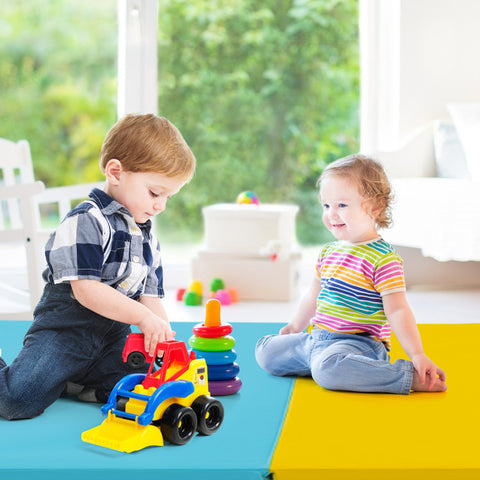News
Silent Strength: The Role of Noise Reduction in Modern Gymnastics Mats
Behind every leap, landing, and tumble, there’s a rhythm that defines the sport of gymnastics. But not all sounds are desirable, in training facilities and home studios, constant thuds and impacts can lead to noise fatigue, distraction, and discomfort.
Modern equipment designers have addressed this issue by developing noise-reducing gymnastics mats that balance shock absorption and acoustic control. These mats not only protect athletes but also create a calmer, more focused training atmosphere, ideal for schools, gyms, and home practice spaces.
Understanding Noise in Gymnastics Environments
Every movement on a mat generates vibration energy. While part of this energy is absorbed by the foam (to cushion the impact), some transfers into the floor or air as sound waves. Over time, these repetitive sounds can cause:
- Disturbance to nearby rooms or neighbors.
- Auditory stress for athletes and trainers.
- Reduced concentration during fine-motor routines.
To solve this, manufacturers have started integrating acoustic damping technology directly into gymnastics mats.
The Technology Behind Noise-Reducing Mats
1- Multi-Layer Acoustic Foam Design
Noise-reducing mats use dual-density foam layers: a soft upper layer absorbs high-frequency impact sounds, while a denser lower layer dampens low-frequency floor vibrations. This combination reduces both “thud” and echo effects.
2- Vibration-Dispersing Base
A key element is the rubberized or microcell base layer that prevents sound waves from traveling through the floor. This is especially important in multi-floor training centers or home setups where sound transfer is a concern.
3- Seamless Compression Fabric
High-quality mats are covered in tight, acoustically neutral fabric (often vinyl or PU blend) that prevents surface slap sounds — common when landing on hard-coated mats.
4- Closed-Cell Structure for Impact Isolation
Closed-cell foam traps air in a way that limits vibration travel between layers, minimizing both noise and shock at once.
Benefits of Noise-Reducing Gymnastics Mats
- Enhanced Training Focus
A quieter training environment improves concentration, allowing gymnasts to focus more on precision and form.
- Reduced Stress for Instructors and Spectators
Coaches can communicate instructions clearly without shouting over noise, while spectators experience a more pleasant environment.
- Improved Safety Through Better Energy Balance
Sound damping and shock absorption often go hand in hand, a mat that minimizes noise usually provides more controlled energy dispersion, reducing joint strain.
- Ideal for Home and Shared Spaces
These mats are excellent for home training areas, school gyms, or apartment setups where minimizing floor impact noise is crucial.
Acoustic Engineering Meets Athletic Design
Noise reduction is achieved without sacrificing performance. In fact, top-tier mats use acoustic-grade foams calibrated for rebound speed, meaning gymnasts still experience the right amount of bounce for tumbling and landing.
Designers also use CAD modeling to test how vibrations move through each mat layer, optimizing the structure to balance both silence and safety.
Maintenance Tips for Noise-Reducing Mats
- Avoid high-heel shoes or sharp objects on the surface to preserve foam integrity.
- Clean regularly with pH-balanced solutions to maintain acoustic fabric quality.
- Rotate mats occasionally if used heavily on one side to ensure even wear.
- Store in dry conditions to prevent moisture from degrading the damping foam.
Proper maintenance ensures both the silence and safety properties last for years.
When to Choose a Noise-Reducing Mat
You should consider investing in this type of mat if:
- You train in an indoor apartment, school, or multi-use facility.
- You want reduced echo or impact thuds during tumbling practice.
- You run a professional gym that values comfort and acoustic design.
- You prioritize joint safety and stable landings with minimal sound interference.
Conclusion
Gymnastics mats have evolved beyond basic cushioning — they now embody engineering precision, performance safety, and acoustic intelligence. Noise-reducing mats represent a modern innovation that transforms the way athletes train: safer, quieter, and more focused.
By combining impact management with sound control, these mats enhance not just performance, but the entire training environment. In the pursuit of excellence, even silence can be a strength.
FAQs
1. What materials are used in noise-reducing gymnastics mats?
They typically combine high-density EVA foam, acoustic damping rubber, and PU-coated vinyl for sound and shock control.
2. Do these mats feel softer than regular mats?
Not necessarily — they are engineered to maintain the same rebound properties, with added layers for sound absorption.
3. Are noise-reducing mats heavier?
They can be slightly heavier due to the dense base layer, but remain portable for gym or home use.
4. Can they be used outdoors?
Yes, if labeled for outdoor use, but extended exposure to direct sunlight or rain may reduce acoustic efficiency.
5. Are noise-reducing mats worth the extra cost?
Absolutely — for facilities where focus, communication, and comfort matter, they provide lasting value and reduced wear on joints and hearing alike.


